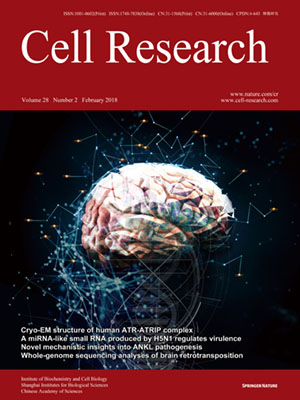
Volume 28, No 2, Feb 2018
ISSN: 1001-0602
EISSN: 1748-7838 2018
impact factor 17.848*
(Clarivate Analytics, 2019)
Volume 28 Issue 2, February 2018: 262-262
ERRATUM
Chemically synthesized histone H2A Lys13 di-ubiquitination promotes binding of 53BP1 to nucleosomes
Jia-Bin Li1, *, Yun-Kun Qi2, 3, *, Qiao-Qiao He2,Hua-Song Ai2, San-ling Liu1, Jia-Xing Wang2,Ji-Shen Zheng1, Lei Liu2, Changlin Tian1
1Hefei National Laboratory for Physical Sciences at the Microscale and School of Life Sciences, University of Science and Technology of China, Hefei, Anhui 230027, China;
2Tsinghua-Peking Center for Life Sciences, Department of Chemistry, Tsinghua University, Beijing 100084, China; 3School of Pharmacy, Qingdao University, Qingdao, Shandong 266021,China
Correspondence: Changlin Tian(cltian@ustc.edu.cn)
p53-binding protein 1 (53BP1) is a critical regulator of cellular response to DNA double-strand breaks (DSBs) [1]. To accomplish its repair function, 53BP1 must be recruited to the chromatin surrounding DSB sites that carry H4 methylation at Lys20 and H2A ubiquitination at Lys15 [2-5]. The structural basis of this recognition process was recently revealed by the complex structure of 53BP1 bound to a nucleosome core particle (NCP) containing Lys20-dimethylated H4 (H4K20me2) and Lys15-mono-ubiquitinated H2A (H2AK15monoUb) [6]. It is fascinating to note that ubiquitin ligase RNF168 ubiquitinated H2A not only on Lys15, but also on Lys13 without selectivity, and H2A bearing the K15Q mutation was still poly-ubiquitinated at Lys13 in vivo [2-4, 7]. This leads to two questions. First, is 53BP1 also a reader of H2A Lys13 ubiquitin mark? Second, is poly-ubiquitination redundant at the 53BP1 recruitment event?
10.1038/cr.2017.157
FULL TEXT | PDF
Browse 2233


